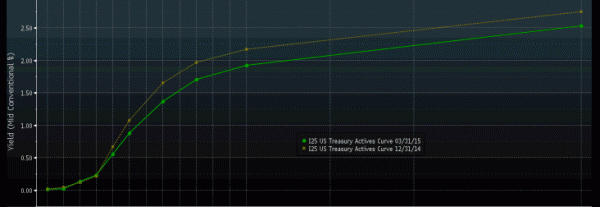
Three issues dominated financial markets in the first quarter of 2015: low energy costs, quantitative easing in Europe, and the prospects of the Federal Reserve raising rates.
Since last summer oil and many energy related products are down more than 50% in the United States. This downturn in prices has led to a downturn in a part of the US economy that was booming. While the energy sector only accounts for 1% of the US economy, it has accounted for 34% of new jobs; however, with the average job paying roughly $100,000 a year, the downturn could have outsized effects. Due to economic and geopolitical reasons, these low prices could continue for a while.
As a result, if Americans see these lower energy costs as less than transitory, the savings could equate to increased consumption which would boost growth. We will have to wait to see how that plays out, but for now the US energy sector is feeling the pinch.
While the US ended its Quantitative Easing (QE) last year, the European Central Bank (ECB) began its easing this year. The ECB will now acquire sovereign debt of Eurozone countries. The ECB will pay negative rates, as low as -.20%, for as long as 18 months and up to $1 trillion US equivalent. Those negative interest rates are suppressing interest rates worldwide, including the US. Yields on Treasuries have fallen 28 basis points on the 5 year to 1.37%, 25 basis points on the 10 year to 1.92%, and 22 basis points to bring the 30 year yield to 2.53%. However, just as the Fed’s QE program had substantial benefits for US equities, the ECB’s QE has so far provided a lift for European equities. For the quarter European equities have rallied, moving close to where they were at the start of 2014, reversing last year’s negative trend despite Greece’s troubles.
1st Quarter Change in the Yield Curve (Bloomberg)
Japanese equities continued their rally in the first quarter. Since the beginning of Abenomics, the yen has depreciated 30% from its peak somewhat muting the stellar stock results for US investors. China’s stock market also rallied toward the end of the quarter as confidence grew that the Chinese central bank would support China’s slowing economy.
Although much of the economic data coming out since the beginning of the year is pointing to a slowdown, the US economy is still moving forward and the Fed is expected to raise rates later this year. This has had a dramatic effect on stocks for two reasons: expectations of a Fed increase, coupled with monetary easing by the ECB, have caused a dramatic rise in the value of the US dollar. Multinationals that rely on foreign sales have seen their income hurt as a result. Because of this, along with the drop in energy prices, analysts have lowered their earnings expectations for the S&P 500 throughout the quarter. From great expectations at the end of 2014, earnings are now projected to be in the red by the second quarter. The end result, the S&P 500 was up only a modest .9% for the quarter. Volatility has increased from its very low levels, as expected and we believe this trend will continue.
1st Quarter Change in the S&P 500 and MSCI EAFE (Morningstar)
Washington Trust Bank believes that the information provided was obtained from reliable sources, but we do not guarantee its accuracy. Neither the information nor any opinion expressed constitutes a solicitation for business or a recommendation of the purchase or sale of securities or commodities.
Washington Trust Bank.